11 Top Rated Helmet Cameras for Motorcycles Reviewed
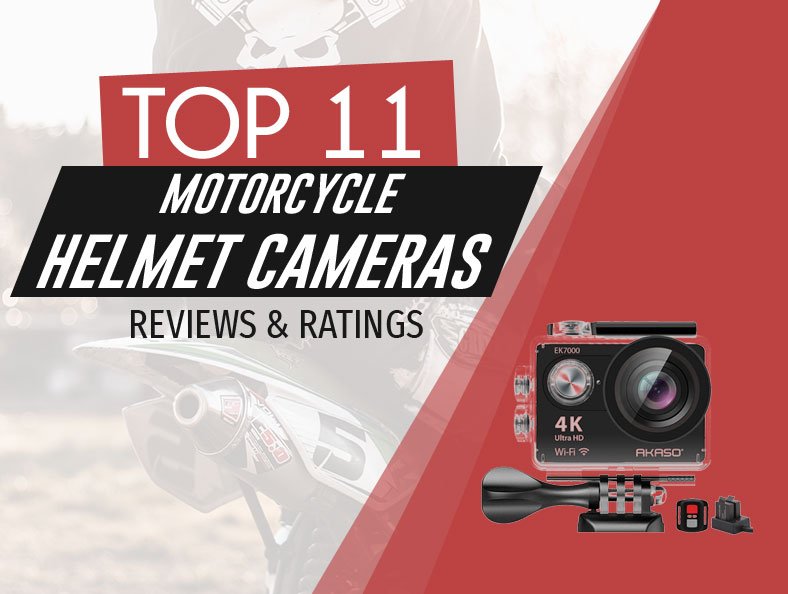
Road Racerz is proudly supported by our readers. Products purchased through links on our site may provide us a commission. Learn More
Riding a motorcycle is freeing, fun, and enjoyable. However, wouldn’t you want to share the thrill with other people?
If so, you might want to invest in a good motorcycle helmet camera. You’d be able to capture the adventure without taking the eyes off the road. Looking at this footage can also help you notice aspects of your ride that you didn’t see before.
However, finding the top motorcycle helmet camera isn’t as simple because there are many models on the market. You should consider several factors before opting for one model.
Continue reading as we share our top choices and all about their pros and cons. You’ll also find a buyer’s guide with info to help you choose one of the cameras.
11 Highest Rated Motorcycle Helmet Cameras Reviewed
| PRODUCT | FEATURES | |
|---|---|---|
Akaso 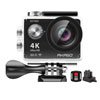 | Akaso Features: 4K 25fps and 2.7K 30fps video with 12MP photos at up to 30 fps Battery life: 2 rechargeable 1050mAh batteries, each battery can record up to 90 minutes Waterproof: Yes, to 100 ft | Check Price |
Campark 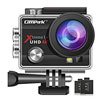 | Campark Features: Records video footage in 4K/30Fps and takes photo at 16M Battery life: up to 180 minutes Waterproof: Waterproof case up to 98 ft | Check Price |
GoPro 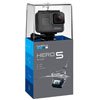 | GoPro Features: Captures 4K video and 12MP photos in three different modes Battery life: up to 115 minutes Waterproof: Yes, to 33ft | Check Price |
Fire Cam 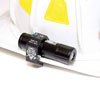 | Fire Cam Features: 1080P/30fps resolution and 720P/60fps in Ultra Wide angle view Battery life: up to 120 minutes Waterproof: Yes, to 33ft | Check Price |
Dragon Touch 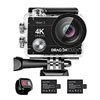 | Dragon Touch Features: 4K/30fps, 2.7K/30fps, 1080P/60fps and 16MP video and photo resolution Battery life: Each battery for 1080P/About 90 mins, 4K/2K/About 60 mins Waterproof: Yes, to 100 ft | Check Price |
Crosstour 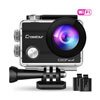 | Crosstour Features: Video Resolution: 1080P/30fps, 720P/60fps, 720P/30fps, Image Resolution: 12MP, 8MP, 5MP, 4MP Battery life: up to 3 hours Waterproof: Yes, to 98 ft | Check Price |
Ion 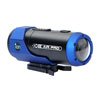 | Ion Features: Record videos in 1080p and 720p, capture 14PM Battery life: up to 180 minutes Waterproof: Yes, to 30 ft | Check Price |
Cooau 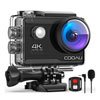 | Cooau Features: Video resolution: 4K/30fps, 2.7K/30fps, 1080P/60fps, 720P/120fps, 20MP photos Battery life: up to 90 minutes Waterproof: Yes, to 131 ft | Check Price |
Apeman 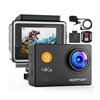 | Apeman Features: HD videos with 4K/30fps resolution and 20MP photos Battery life: up to 180 minutes Waterproof: Yes, to 131 ft | Check Price |
Sena 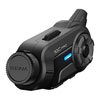 | Sena Features: The camera records in 30fps in full HD and 60fps with Smart Audio Battery life: up to 120 minutes Waterproof: No information | Check Price |
Mengshen 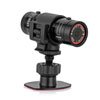 | Mengshen Features: Video resolution: FULL HD 1080P 1920x1080 30FPS/ 1280x720P 60FPS.1080p video shooting Battery life: up to 150 minutes Waterproof: No | Check Price |
Akaso – Best for Extreme Environment
This cam is one of the best to capture your adventures in extreme environments. It’s a wireless wrist remote control camera with built-in Wi-Fi and longer battery life.
It’s a professional camera sporting 4K 25fps and 2.7K 30fps video with 12MP photos at up to 30 fps. This gives you incredible images at four times the resolution of a more traditional HD cam.
This one comes with a wrist 2.4G wireless RF remote control, allowing you to record videos, frame shots, and control the camera in any other way.
It also features two rechargeable 1050mAh batteries, which gives you 180 minutes of runtime.
This means more freedom since you won’t have to worry about running out of battery mid-adventure.
It’s packed in an IP68 waterproof case, which is ideal if you often ride in nature or the rain.
PROS
- Wi-Fi up to 10 meters
- Built-in HDMI
- Waterproof to 100 feet
CONS
- Battery life varies depending on video quality
Campark – Best Resolution
If you’re looking to make high-quality footage, you should consider this Campark cam. It records footage in 4K/30fps while taking photos at 16M. It’s an action camera, so you can use it while biking, cycling, hiking and more.
It has a 2-inch HD screen with a 170-degree lens, allowing you to adjust the viewing angle. Its multiple angles make it easy to see all the background details, giving you a unique visual experience.
On top of that, this one has Wi-Fi remote control, and it works with iOS and Android. It allows you to control it via your phone right then and there.
It features a waterproof case meant to withstand up to 30 meters of water.
This allows you to either use it in the rain or for different water sports.
PROS
- 180 minutes of runtime
- Multiple mounting accessories included
- Waterproof case
CONS
- It’s a bit tricky to connect to the mobile app
GoPro – Best for Travel
At this point, you’ve probably heard of GoPro. It’s one of the most popular compact cameras used for capturing different adventures such as motorcycle riding, travel, biking, etc.
This one captures an impressive 4K video and 12MP photos in three different modes. You can choose between Time Lapse, Burst, and Single modes depending on your needs and preferences. The Time Laps intervals go from 05, 1, 2, 5, 10, 30, 60 seconds.
It features a rechargeable battery, although the charger isn’t included with the cam. Another important thing to mention is the durable design. This one is waterproof up to 33 feet, even without housing.
The cam allows you to change settings and trim your footage according to your preference. You can also preview and playback your shots all on the GoPro.
It comes with a user manual with a full-on explanation of its technical specifications.
PROS
- User-friendly
- Durable, waterproof design
- Impressive stabilization
CONS
- No charger included
Fire Cam – Best Water Resistant
This tiny camera is often a choice among firefighters and different rescue teams. It’s small, lightweight, and easy to mount and dismount at any time.
It comes with a helmet mount and 16GB Class 10 SDHC card for all your videos and pictures. It operates in 1080P/30fps resolution and 720P/60fps in Ultra Wide angle view.
On top of that, this one sports several video and photo modes such as auto low-light, time/date stamp, and several others. It offers up to two hours of runtime.
As we mentioned, it’s packed inside a highly durable case, which is ideal for rough terrain and unpredictable weather conditions.
The cam itself isn’t waterproof, but it’s water-resistant so that you can still use it in the rain.
PROS
- Compact and lightweight
- Two hours of runtime
- HD resolution
CONS
- Not the best in low-light conditions
Dragon Touch – Best Versatile
If you’re a motorcyclist who’s also into other sports and activities, you might want to check this one if you’re going to record your adventures.
It’s a 4K/30fps, 2.7K/30fps, 1080P/60fps and 16MP video and photo resolution. This helps you capture some amazing footage when riding. Its zoom range is from 1.0X to 4.0X.
It comes with the wireless wrist remote control, allowing you to set up and use the camera without actually dismounting it each time. This also makes it easier to capture different things in places you can’t reach. Its wireless range is up to 33 feet.
This one has a 2’’ screen, which lets you preview the video right then and there.
It also connects to your phone or tablet with App XDV if you want to see it there.
It comes with two 1050mAh batteries and functions such as image rotation, driving mode, time-lapse, slow motion, and more.
PROS
- 100ft waterproof
- Easy to mount and use
- Built-in Wi-Fi
CONS
- On/off/shoot sounds cannot be muted
Crosstour – Best Waterproof
Although many helmet cameras are waterproof to some extent, you should pay special attention to this if you know you’ll use it in water. This Crosstour cam is one of the best options for capturing high-quality videos and pictures underwater or in the rain.
Its 170° wide-angle lens lets you create wide scenes, capturing more exciting videos than ever. On top of that, the cam is packed inside a waterproof case, allowing you to dive in water up to 98 feet. As such, it’s also safe to use in the rain if you’re ever caught in it while riding.
It has a wireless control connection, easily connecting to your phone.
This allows you to operate it in the iSmart DV app, so you can record videos and take pictures.
PROS
- 18 different accessories included
- Waterproof casing
- Has remote control via Wi-Fi
CONS
- It loses date/time settings when changing batteries
Ion – Most Durable
Since motorcycling can be rough depending on the terrain, you should consider a cam that’s a bit more durable. It’s a professional camera packed in a durable casing. It’s also waterproof without a case up to 30 feet.
It has a 170-degree field of view, allowing you to record videos in 1080p and 720p. The cam has a built-in quality microphone, which helps when recording audio as well. When it comes to pictures, you get to capture 14PM still, time-lapse, and burst-shot images.
Its battery lasts approximately 2.5 hours, but that usually depends on the mode and quality of the footage. It fits Micro SD/Micro SDHC class six as a minimum, although class 10 is the recommended one.
The cam has Wi-Fi and Shoot/Share functionality, allowing you to upload your footage in real-time.
PROS
- Real-time sharing
- Durable case
- Three shooting modes
CONS
- It’s a bit challenging to mount on some helmets
Cooau – Best for Sports
This one comes with a 7-layer optical glass lens that delivers HD 4K videos and 20MP photos. When it comes to video resolution, it has 4K/30fps, 2.7K/30fps, 1080P/60fps, 720P/120fps, offering you incredible footage of your riding adventures.
The reason why this is one of the best cams for sports is its EIS stabilization program embedded in the chip. This provides video fluency and stability during different adventures and sports, biking included.
On top of that, its case is made of durable materials and is waterproof to 40m underwater.
The cam has an external microphone, which is ideal for motorcycling, skiing, and other such activities where there’s lots of noise. Plus, its 170° wide angle allows you to shoot more impressive footage during these adventures.
It has a remote control so that you can control it from 10m away.
PROS
- Connects to your phone or tablet
- Waterproof and durable
- Built-in stabilization
CONS
- No indication light to tell when it’s recording
Apeman – Best for Underwater
This 4K 16MP action camera delivers HD videos with 4K/30fps resolution, allowing you to take stunning footage of your motorcycling adventures. It comes equipped with an advanced sensor and EIS.
It offers several recording modes such as time-lapse, slow motion, selfie timer, auto mode, and loop recordings. It comes with several mounting kits for you to use when motorcycling, biking, diving, swimming, etc.
The cam operates with 2.4G remote control within the 10m range. It has Wi-Fi connectivity via an app, allowing you to control the device and download all the files to your tablet or phone. It also has USB and HD out ports for playing and transmitting data on TV or PC.
Its casing is sturdy and durable while the cam is waterproof to 40m underwater.
PROS
- Remote control
- HD videos and pictures
- Waterproof case
CONS
- Going from shadow to light might cause some loss of detail
Sena – Best Noise Control
Noise is a massive problem in helmet cameras, but this Sena cam offers a bit more noise control than other similar models.
This one is equipped with 2K camera specifications and voice prompts, proving excellent performance in different conditions. It features advanced noise control and a four-way intercom for better sound quality.
The camera records in 30fps in full HD and 60fps with Smart Audio. Its lens rotates up to 30° so that you can make more exciting footage regardless of whether you’re biking, cycling, or running.
It’s also important to mention that it comes in a durable case, so don’t be scared of breaking it during those adventures. On top of that, the cam is also remote-control compatible and has Wi-Fi enabled.
PROS
- Works with Sena smartphone apps
- Great footage with quality sound
- Durable case
CONS
- Only 90 minutes of runtime
Mengshen – Perfect for Outdoor Sports
If you’re into different outdoor sports as well as motorcycling, you should consider this Mengshen cam as one of the best for the job.
With a versatile video resolution, you get to shoot videos in different quality depending on your needs and preferences. On top of that, the cam has some 2.5 hours of runtime, which is always a plus in helmet cameras.
Apart from its specifications, its size also adds a lot to the overall convenience. It’s a compact camera, but with a wide-angle of 120 degrees. As such, you’ll find it easy to use on various occasions.
The camera has a ¼-inch, low-noise photosensitive element, allowing you to capture pictures in low light conditions.
However, keep in mind that it’s not waterproof but only water-resistant. While it can endure some rain, it cannot be submerged in water.
PROS
- Built-in microphone
- Long battery life
- Wide shooting angle
CONS
- Not waterproof
A Shopper's Guide for Helmet Mounted Cams
Wi-Fi Ready
Having a Wi-Fi ready helmet camera offers many benefits and advantages. Luckily, many high-quality models feature Wi-Fi capability, allowing you to use the global network.
Wi-Fi allows you to monitor your camera remotely with your smartphone. In most cases, you can do this through an app, depending on whether you’re using Android or iOS. This also means easier access to the recorded footage and other files. Through an app, you can view, download, and manage the data easier than ever.
Having Wi-Fi on your camera also allows you to send all the pictures and videos to your social media accounts without too much hassle. You don’t have to go home and use your computer to share your footage since the process is much simpler.
Most cameras allow you to upload pictures and videos to social media in real-time. This way, everyone can see what you’re up to. This way of sharing images is quite convenient, especially if you’re passionate about travel photography.
Keep in mind that you’ll have to pay attention to your camera’s Wi-Fi range. This is usually different for every model, so it’s a matter of choosing what works the best for you.
You might also want to check if the cam has Bluetooth. Though it seems less significant, Bluetooth is a good feature to rely on if Wi-Fi isn’t an option at a certain time.
Camera's Superior Image Quality
A camera mounted on a helmet is going through a lot of shaking and moving. For this reason, you might want to invest in the one with great image quality, just so your footage doesn’t end up all blurry and shaky.
Now, these aren’t always expensive, although they tend to cost more than your average cheap cam. If you’re on a budget, you shouldn’t just pick any cheap cam otherwise you won’t like the quality of pictures. Instead, see which features you can work without while you’re sticking to image quality.
The camera of your choice will have to endure lots of shaking and fast speeds while taking pictures or recording videos. For this reason, you need an action or sports camera made specifically for the job.
The HD resolution is probably the lowest you should settle for when it comes to videos. Ultra HD is somewhat better because it provides higher quality in both videos and pictures.
Still, some of the most popular cameras offer 4K for videos and 12MP for pictures, which should be your first choice if you’re aiming for quality. However, these are typically somewhat pricier than HD and Ultra HD cameras, so make sure to check if this is within your budget.

Camera's Battery Life
Battery life is among the most critical specifications to pay attention to. While resolution and lenses matter, none of it can work without decent battery life. For this reason, make sure to check the exact numbers for the model you’re interested in.
Most action cameras have rechargeable batteries, so we suggest you to check what batteries go in there and how much life you can expect. In most cases, lithium batteries are the most reliable option since you can recharge them many times.
Since battery life is never the same in all models, you should aim for at least an hour of continuous use on one charge.
Some brands offer a spare battery or two, so make sure to bring them with you on your biking adventures. This will allow you to simply replace the battery if it runs out while you’re outside.
Another thing you should check is if your camera comes with a charger or not. Oftentimes, people pay attention to batteries and their power, forgetting to check if there’s a charger included.
Type of Lens
Having a camera attached to your helmet brings many advantages and fun possibilities. It should allow you to capture a wide field of view, resulting in impressive footage of your adventures.
This is why you should pay special attention to the type of lens the cam of your choice comes with. In most cases, different models are equipped with a fish-eye lens. It’s an ultra-wide lens with an angle of 170 degrees.
These models usually also have a widescreen, which allows you to view the videos you’re recording. This makes it easy to understand what exactly your camera sees and how you can take advantage of it.
Keep in mind that some models might not feature a fish-eye lens, depending on the manufacturer and price. Though it’s not the most important feature, it’s definitely something you should aim for to make fun videos of your surroundings.
You’ll notice that some models come with different lenses. This is alright as long as you keep in mind a few things. For example, a wide field of view allows you to make a better recording of your surroundings.
This is crucial if you’re looking to use the video to inspect the area later on. Videos and images both look better when done through a wide lens, so that’s something to consider.
Types of Helmet Video Cameras
Integrated
These feature Wi-Fi, GPS, 4K resolution, and other similar features all bundled together. It’s a whole package, meant for people who want to edit their videos.
In most cases, integrated cameras can be mounted in different places, from helmets to windows and dashboards.
Single Unit
Single-unit cameras are smaller and lighter than integrated models. These are the more basic type, allowing you to record videos and take pictures without any special features.
Riders usually use single-unit cameras for recording videos to review later. It helps to inspect the area and get to know it better.
Camera Pricing
$60 & Below
Typically, you can find high-quality helmet cameras within this price range. In most cases, they come with standard features, video recording, and capturing. Extra features like GPS and Wi-Fi may or may not be included, depending on the particular model.
Generally, it’s a solid price range, so just take your time with finding the right camera that suits your needs and fits within this budget.
$60-$100
Spending a bit more also means you’ll get a bit more than just recording and capturing. Helmet cameras in this price range usually have more functionality. Things like wider camera angles, 4K video recording, long-lasting batteries, and touch-screen are just a few things you can expect from a model within this budget.
$100 & Up
In most cases, cameras that are $100 or more feature all of the features we mentioned above. Sometimes, a few others are included, as well.
At first glance, these look sleek and compact, unlike the somewhat bulky low-budget cams. Typically, these also have night vision and low-light effects, allowing you to record videos at night as well. They usually also feature Bluetooth.

Other Key Features to Consider
Screen
A 2-inch screen is the standard screen size when it comes to helmet cameras. Look for the one that has a built-in screen so that you can immediately review the footage you created.
Size & Weight
Size and weight play a significant role in how convenient and easy-to-use the cam is. Remember that you’ll wear it on your head, so you don’t want anything too bulky and heavy. Lightweight cameras don’t affect your balance or posture as much.
Settings and System
Different cameras come with different settings, allowing you to choose based on your needs. While certain things may not be as relevant to you, there are several things you should consider when it comes to system and settings.
Because it’s impossible to control the camera while it’s mounted on your helmet, you need one that has remote or voice control.
Probably the most important setting to look for is loop recording. It allows you to record videos at all times regardless of your storage space. The camera overwrites old recordings, so you cannot actually run out of space for new footage.
Many newer models activate loop mode automatically when the shock sensor detects an impact. In some cases, you can turn this off if you’re riding in bumpy, off-road terrain.
Sound
Most motorcycle helmet cameras have a built-in microphone. Though sound quality may not be important to some, it’s definitely something to consider.
Mounting
As we mentioned, it’s important to have a secure mounting system that’s also easy to work with. Adhesive mounting is probably the best option that doesn’t require any helmet modifications.
Cloud or SD Card Storage
This is up to you and what you prefer in terms of storage. Some cameras come with SD cards while others upload stuff directly to your Cloud. Either way is good, but keep in mind that Cloud requires a subscription.
Protective Case
Since you’ll be on your motorcycle, you need a durable camera that won’t break in case of an impact. For this reason, consider getting one that has a reliable case that’s strong enough to protect your camera from breaking.
However, make sure that it can continue recording so that you know what led to the impact.
Benefits of Use
There are many benefits to using a helmet camera. Not only it’s fun, but it can also be quite useful in analyzing your rides. Here are some of the most significant advantages:
Insight in accidents – probably the most important part of riding with a helmet camera is the ability to record accidents. In case it comes to a crash, you have footage to check what led to it.
Versatility – motorcycle helmet cameras have different features such as GPS, Wi-Fi, and hands-free control. This means you can also use them as dash cameras in your car. It’s a great way of reviewing your ride.
Inspect different angles – you don’t have to do much more than focus on the ride ahead. Your cam captures footage of the different things around you that you maybe didn’t see when you were there. This gives you a new perspective of things to pay attention to the next time you’re on the road.
Create montages – some cameras allow you to record and edit your footage on the go. However, you can also connect it to your computer to get the most of the videos and pictures you captured. It’s a good thing to have if you’re filming for promotional or training purposes or want to make some fun videos for your social media.
Frequently Asked Questions
What's the best motorcycle helmet camera mount?
While there are many motorcycle helmet camera mounts out there, it’s up to you to decide what would work the best for you.
In most cases, you should go for the one that’s easy to set up and use without too much hassle. It’s also vital that it doesn’t require any helmet modifications.
Pay attention to how sturdy and durable the mount is, especially if you ride in bumpy, off-road terrain. Also, make sure it’s compatible with the camera of your choice.
Is it legal to wear one?
This has been a hot topic for a long time. There’s no law to stop you from using a helmet camera, depending on how you mounted in.
In other words, what’s illegal is modifying your helmet in order to mount a camera to it. You cannot drill or compromise the construction of a helmet in any other way.
Conclusion
If you came this far, you probably understand the many benefits that a motorcycle helmet camera brings. Not only it’s fun to film your rides, but it can also be quite helpful in figuring out what you did wrong.
Having a video of your ride can help you notice things you maybe didn’t see then and there. Plus, you can use this footage for all sorts of things.
Still, make sure to consider all the buying factors we mentioned in our guide. It can help you figure out which of the cameras we reviewed is the best for your needs.

















